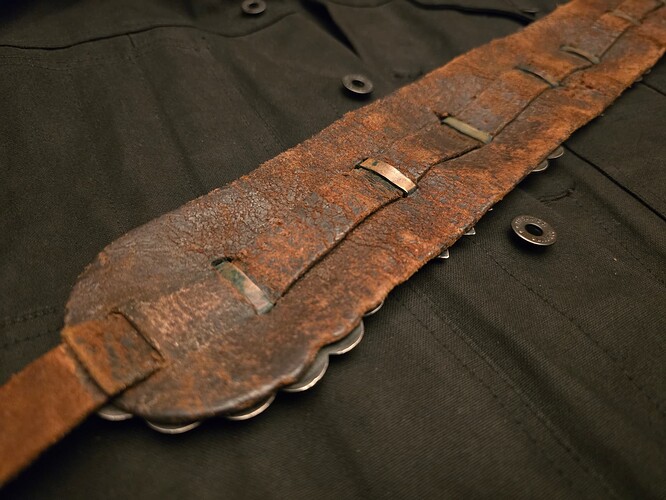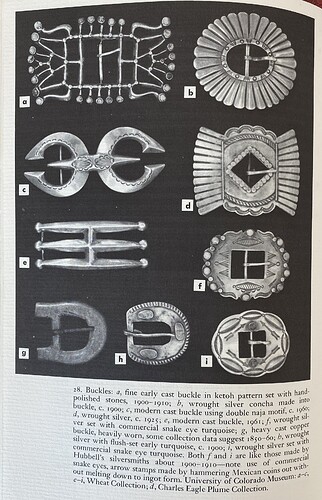Of course, I didn’t even see that. At first it reminded me slightly of a bridle bit. Although the first photo you just posted (the one with the turquoise in the middle) makes me think of the Star Trek Enterprise ![]()
They do certainly remind me of a bridle bit.
![]() “Star Trek”, I would never have seen that!
“Star Trek”, I would never have seen that!
Wow, not sure where to begin, Aaron! In my eyes, this is a world-class collection and one that shows the passion, commitment, and journey it took to acquire such special pieces. Hard to pick a favorite belt because they’re ALL wonderful and the beautiful weaving they’re presented on makes for a magazine worthy photograph. But every collection has its pinnacles and for me, #5 and #6 are the obvious standouts showcasing early, classic Navajo design and silverwork. Fantastic!
As for your buckles, there isn’t one I wouldn’t be proud to wear. I know we’ve discussed #2. Tell me more about #1 and your favorite, #6, with the teardrop stone settings.
BTW, there is nothing wrong with your leather work on #4. You did a great job of recreating a traditional wide belt. And I agree with Zia, belt #3 with the black leather has it going on.
You are too kind @TAH. Thank you for your enthusiastic response, it means alot coming from you.
Belts 5 & 6 are closest to my heart, followed closely by belt #4. My passion for earlier work has grown exponentially over the last couple of years, and the aim of my collecting has shifted in that direction. This evening I will put together some close up photos and weights.
Buckle #1 measures 4 5/8" x 3 1/2", with a 5/8" dome, hand hammered and stamped, it weighs in at 106 grams. I believe it to be crafted in the style of Phase 1 conchos, but my uneducated date estimate is maybe 30’s-40’s? It was advertised as much earlier, but I think not. While not as refined or crafted to similar standards as my preferred buckle, #2, I do enjoy it, and it’s got a warm, deep patina.
I believe my rambling responses to @Ziacat led to some confusion. I had intended to say that belt #6 was my favorite, I apologize for the misleading statements. The cast buckle with teardrop turquoise settings is ca. 30’s-40’s. I don’t believe an enormoues amount of time was spent carving the mold, as the rectangular perimter of the buckle has some slight “parallelogram like” geometry, but I still find it beautiful, and I’ve always enjoyed the stones.
Thank you for you words concerning belt #4. I’m working on some Crazy Horse belts that I will dedicate a few buckles to, and will replace this belt with, I much prefer it over what I crafted originally.
The black leather and buckle on #3 is what initially caught my attention. While it may be a bit smaller than what I prefer nowadays, I do enjoy it. It bears some beautiful stampwork as well.
I’m thinking @TaraFawn75 would love all these, but I haven’t seen her for a while.
Don’t be too hard on #3’s smaller size. It’s the overall package that makes the statement and the black leather really sets off the turquoise and silver. Plus, I like the variety of sizes and styles within your collection. Makes it more interesting with different examples.
I agree on all fronts @TAH. That belt was one of my first acquisitions. The relationship of the conchos’ size to their convexity…![]() …is another feature I appreciate of that belt. It may be smaller, and have more recent leather, but it’s still a keeper in my book.
…is another feature I appreciate of that belt. It may be smaller, and have more recent leather, but it’s still a keeper in my book.
I deeply admire the art of the belt and buckle, all manner of size and style catch my eye. As many of us here well know, there are plenty fine examples available!!!
Here are some closer photos of the belts that @Ziacat and @TAH pointed out.
Belt #3, ca. 30’-40’s, 341 grams (including leather
Belt #5, Conchos ca. 1900-1910, sandcast buckle and leather dating later, possibly 40’s, 860 grams (including leather)
Belt #6, ca. 20’s, original leather, 851 grams (including leather)
Thanks for the clear, up close photos, Aaron. Really enjoyed seeing the detail and quality silver work on all three belts. The height of the repousse on the first belt conchos is stunning and impressive.
The cast buckle on the second belt is just simple, understated, elegance. As you mentioned, the leather strap appears to be later, but not necessary the leather backings which show age appropriate shrinkage.
To me, the third belt is museum worthy. All original and the stamp and silver work is next level. This belt was created by a highly skilled, highly experienced, silversmith.
Heck, I even like all three handmade prongs and the plug for Filson. ![]()
I hadn’t really considered that the backings on the second belt could be earlier than the strap, but as you pointed out, they do portray appropriate shrinkage, and they are more firm than the belt as well, so perhaps they do date earlier than the strap. That belt’s prong is, I feel, a work of art. It’s reminiscent of a parabolic curve, carinated to the pointed termination, but flowing into a square profile as it wraps the post. I find it very well executed.
I’m glad you guys have enjoyed, it’s great sharing our passions with the like minded. ![]()
If anyone was to mention that, I felt it would be you @TAH. While not jewelry related, I am a long time Filson fan. Their earlier wool vests are unmatched. When they can be found, (in my size) I snatch them up. They are certainly one of the greatest outfitters that was ever established.
Same here, Aaron. My father wore a Filson ranger belt for years then stopped wearing it, so I re-worked both ends to make it fit me. The billets are 3/4", so they fit my Skeet buckle perfectly. Dad supplied the great wear on the leather. ![]()

This is lovely Tom. What a great history of the belt and the addition of your Skeet buckle really makes for a magnificaent presentation! You did a great job modifying it as well, noone would ever be the wiser! The wear on the belt exudes much class and is very pleasing. ![]()
![]() Thank you for sharing!!
Thank you for sharing!!
Aaron, here’s a similar buckle to your #3. Unfortunately, I can’t remember which book it was in when I was snapping photos at our public library. They’re dating this one circa 1960.
Thank you for sharing this, Tom! Very similar indeed. This photo contains quite a few beautiful examples. I’m all about b and d.
Looking at some of the stampwork, the stamps are really something. Great stuff! One doesn’t see stamps made this way anymore.
Hey Mike, thank you for your compliments, your words are valued and respected.
I’m always eager to learn, and others will certainly find your insight valuable as well. Could you please elaborate on this?
The stamps I’ve circled are good reference examples. Navajo stamps are usually made from found objects like automotive leaf springs, valve stems, broken files, cement nails. Anything made from tough high carbon tool grade steel which can be tempered to an ideal hardness for use in jewelry making.
The process for making handmade stamps is first to anneal (heat soften) the steel so that it can be shaped, filed, and worked with hardened steel stamps into the desired form and design.
Today, commercial grinding wheels and specialized burrs are often used do most of the shaping, with the finishing design touches being done with a combination of simple stamps, files, and things like separating disks on a dremel or flex shaft. Finally the stamp is tempered with heat and quenching to an ideal hardness, with an emphasis on getting through the process as quickly as possible to keep the stamp making efficient and profitable.
The difference in these older stamps is, no expense in terms of time was spared in the making of the finished stamp. Shaping was done primarily with hand files, and the design work rather than being say simply the shaping the stamp, plus hammering into the teeth of a file to create texture, was more studied and complex.
Here individual design stamps (some rather complex) were made to pattern each element of the final finished design stamp, doubling or tripling the complexity and amount of time required to make each stamp, with each stamp itself being an individual work of art, and as unique and individual to its maker as a fingerprint.
Thank you, Mike! You just helped me gain a whole new level of appreciation for quality Navajo stamp work.
Sorry, off-topic … my bracelet has also some amazing stamp work. This has really drawn my attention, what a beauty. Some crafters really invest all their creativity and time to create something fascinating & unique.
Looking at these excellent, detailed photos is a real treat for me, Tom! I geek out on this stuff.
















